I’ve been eating miso soup since I was a little girl and this is my mother’s recipe, which happens to be my favorite of all time! Savory, sweet, nutty, and made with only three ingredients, you won’t believe how comforting it is. Ready in 15 minutes from start to finish.
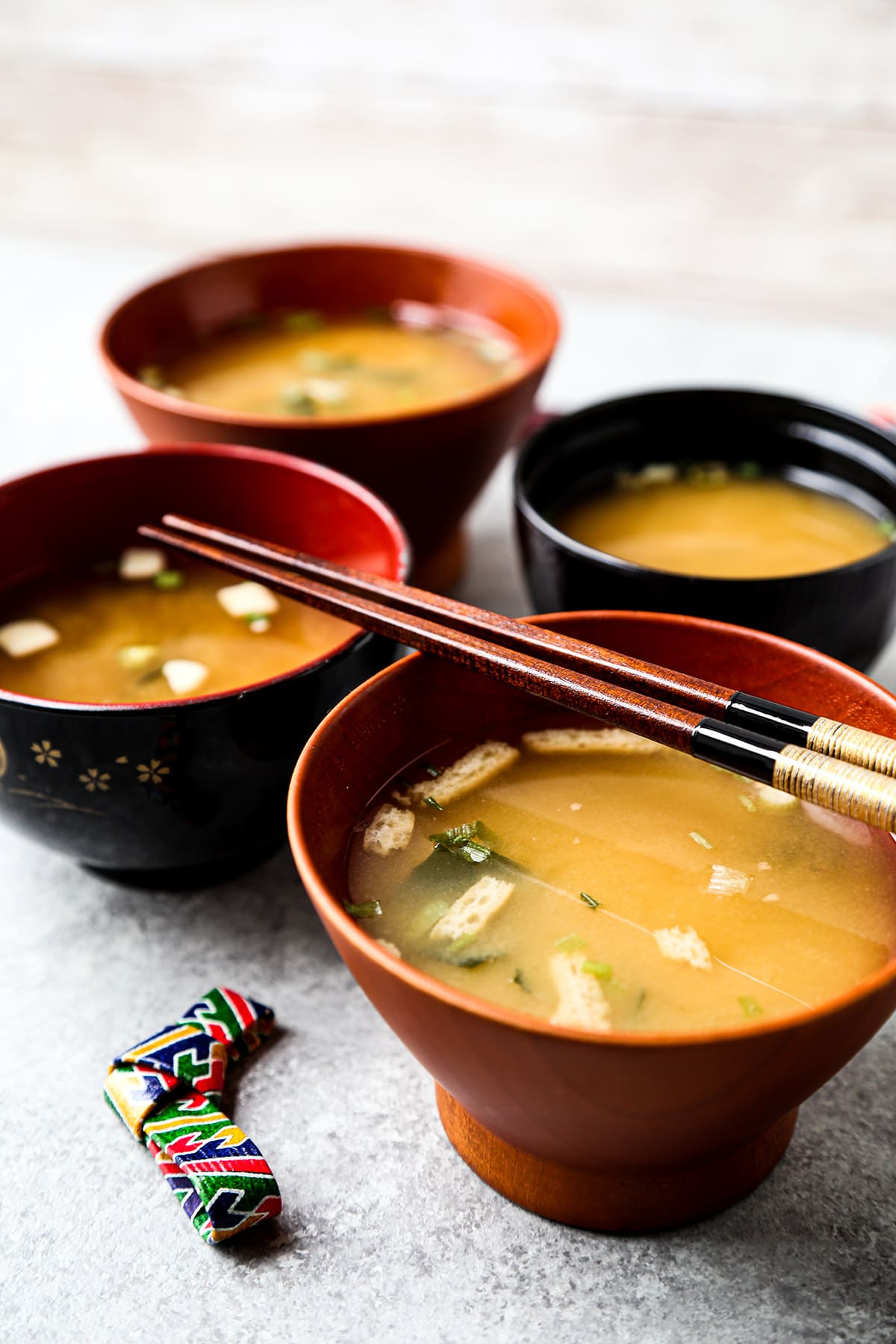
Miso soup is one of the most famous Japanese dishes of all time. Next to sushi, it’s what most people refer to whenever they say they crave Japanese food. While it’s usually served together with a salad as part of an appetizer in the US, miso soup comes with rice as part of a main meal in Japan.
My mother makes the best homemade miso soup. And although it’s unlike the classic tofu and wakame miso soup we are used to seeing here in the US, her version can be easily found across homes and restaurants in Japan. There are so many different types of miso soups in Japan that it would take too long to list them all. Some of my favorites are maitake mushroom miso soup, potato and onion miso soup, eggplant miso soup, nameko miso soup, clam miso soup, and aonori miso soup.
For this recipe my mother only uses chopped onions, dashi and miso paste. The soup takes on a sweet fragrance called amami (あまみ), making the soup mild yet still deep in flavor. The onions are boiled until tender and literally melt in your mouth, it’s absolutely delicious!
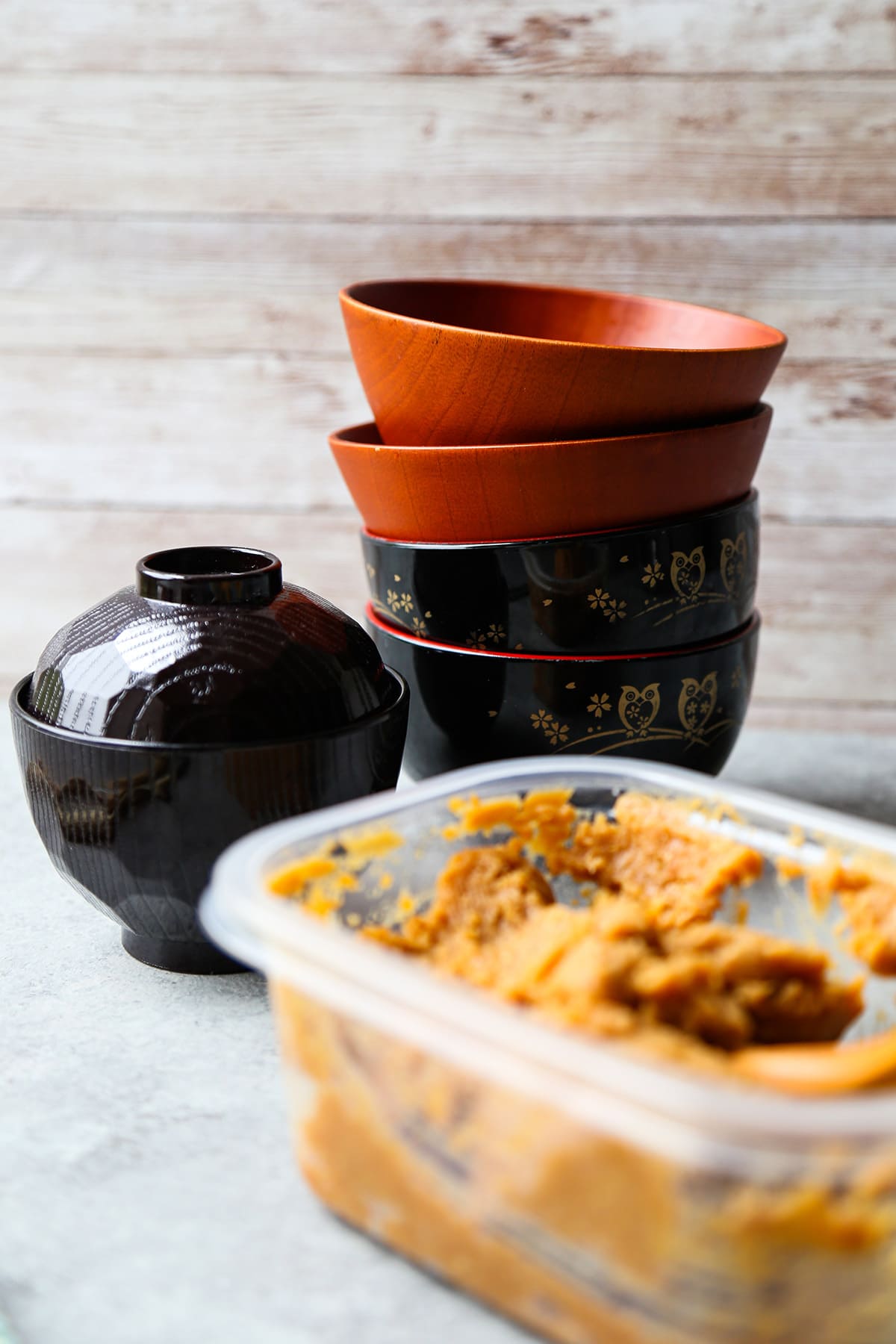
Best Miso Paste For This Recipe
There are many different types of miso paste but the three most popular ones used for miso soup are:
- White Miso Paste – (Shiro Miso 白味噌) : White miso paste is the sweetest and mildest of all three miso pastes (made with 40% soybean and 60% rice or barley grains). Because the fermentation period is shorter than other types of miso paste, the flavor is much more delicate than the other two types. White miso paste is often used in southern Japan where they prefer milder broths and sauces.
- Yellow Miso Paste – (Awase Miso 合わせ味噌): The word awase in Japanese means “to mix”, and that’s exactly what this miso paste is – a mix of white and red miso paste. You get the sweetness of the white miso paste mixed with the smokiness and saltiness of the red miso paste. It’s a powerful combination and one that yields a bowl of miso soup where the flavors are in perfect harmony.
- Red Miso Paste – (Aka Miso 赤味噌): Red miso paste is the strongest, most punchy type of miso paste. It’s pungent, nutty, salty, and packed with umami (made with 70% soybean and 30% rice or barley). It has so much depth in flavor that I sometimes find it overwhelming, which is why I prefer awase miso. Needless to say a little goes a long way here!
You can technically use any of these three types of miso paste to make this miso soup but I recommend using white miso paste because that’s the one my mother uses. Awase miso paste is the second best option but one I prefer using for dishes like regular miso ramen or spicy miso ramen, nasu dengaku, or to make a simple miso dressing.
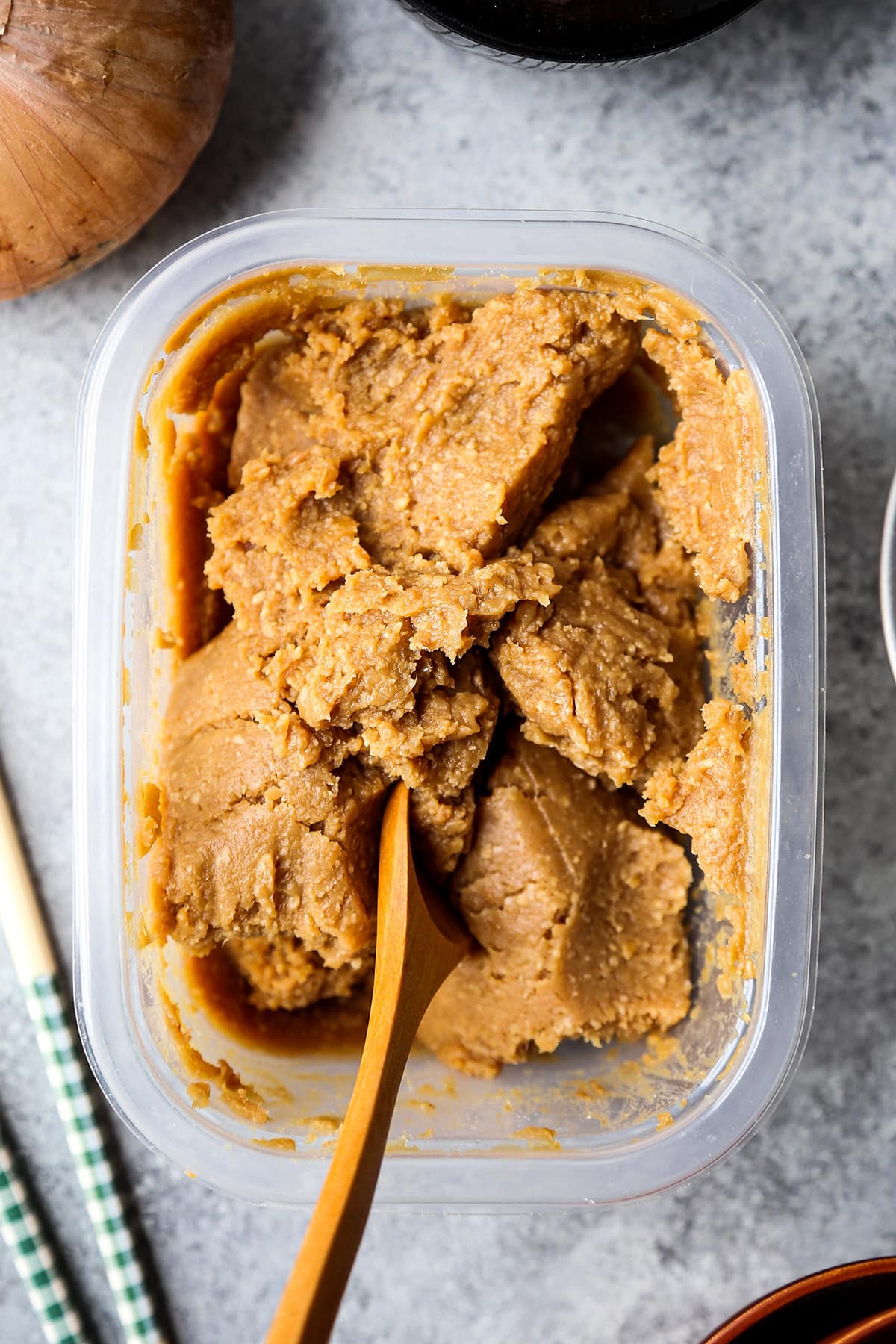
Cooking Equipment
- Chef’s knife. To slice the onions.
- Small or medium size pot. To cook the soup.
- Small strainer. To strain the miso paste.
- Serving bowls. To serve the soup.
Ingredients
- Onion: Don’t be afraid to use a lot of onions in this recipe since it adds a lovely flavor to the soup. And once the onion slices are boiled, they are so tender they almost melt in your mouth.
- Water: 4 cups of water or 4 cups of dashi if you are making it from scratch using bonito flakes or kombu.
- Dashi powder: While the ratio of dashi powder to water is usually 1 teaspoon per 1 cup of water, for miso soup, less is used. That’s because miso paste is the main flavor of the soup. You will only need 1 tablespoon of dashi powder for this recipe.
- Miso paste: I recommend using white or awase miso paste. Both of these options yields a soup that’s milder and less salty than the strong and pungent red miso paste.
- Ichimi togarashi (optional): Optional but a must for myself! I always add a sprinkle to infuse a little heat.
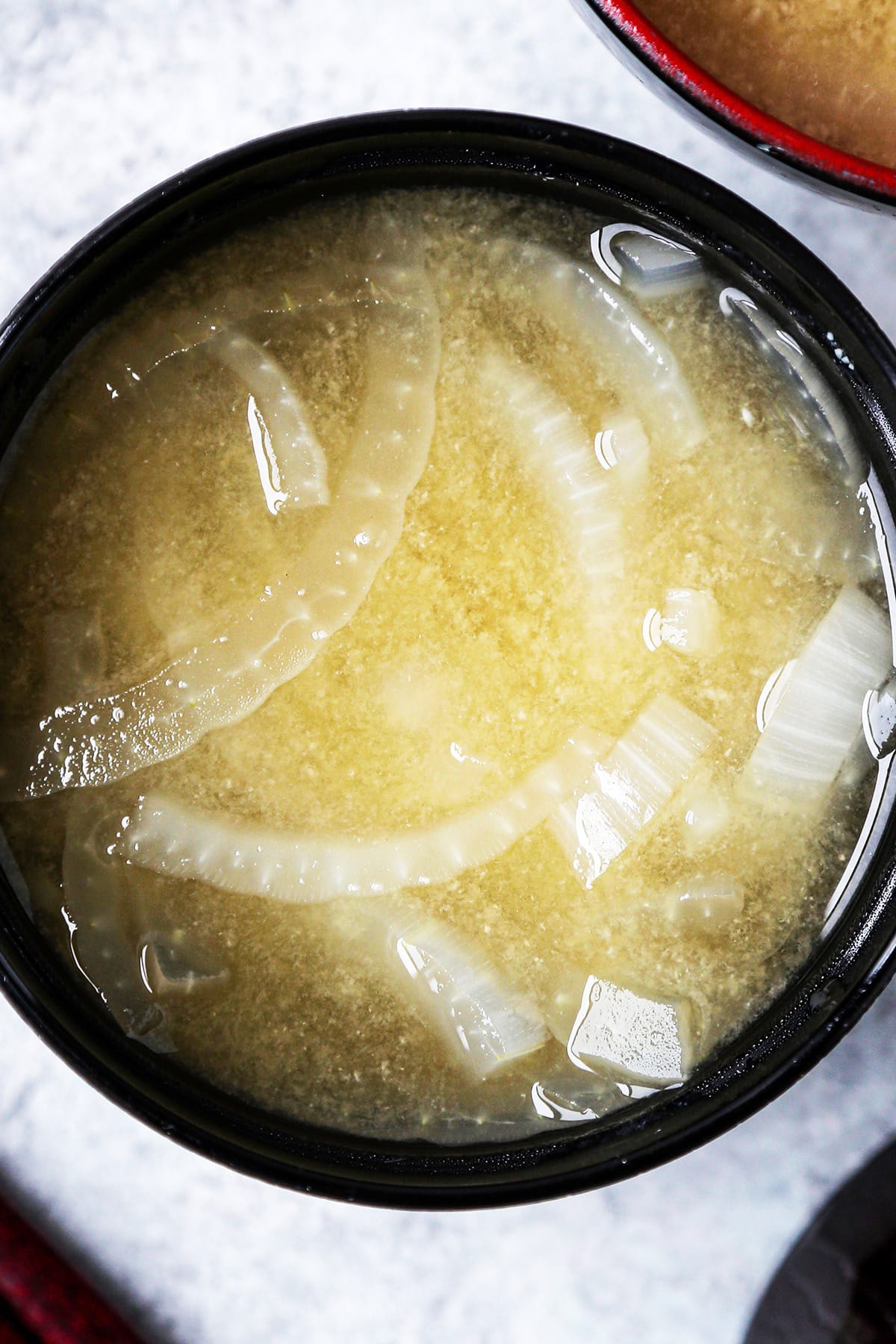
How To Make Miso Soup
- Add 4 cups of water, onions and dashi powder to a pot and bring to a boil.
- Lower the heat, cover and cook for about 10 minutes, until the onions are tender.
- Place the miso paste in a colander and lower it into the pot until enough water covers the miso paste.
- Using chopsticks, swirl the paste until it completely dissolves into the soup.
- Turn the heat off and serve.
Variations
- Make it traditional. For the traditional miso soup with tofu and seaweed, bring the water and dashi to a boil, add the tofu and cook for 2 minutes. Follow the same steps for dissolving the miso paste, and finish by adding the seaweed (wakame).
- Make it vegan. Use kombu dashi instead or regular dashi which is made with bonito flakes (katsuobushi). Also, make sure that the miso paste you are buying doesn’t contain any dashi and is 100% miso paste only.
- Make it more filling. Add a couple of pieces of mochi to the soup when it’s boiling and cook them until they have softened. I love eating miso soup this way as I am obsessed with the chewy texture of rice cakes.
- Make it nutty. Adding a drizzle of toasted sesame oil will infuse the broth with a lovely nutty taste. I also sometimes like to add ground sesame seeds for the same effect.
There are so many different ways to serve miso soup! While the broth itself doesn’t change much, there are many ingredients that can be added to compliment it. Deep-fried tofu pouches (aburaage), eggplant, daikon, okra, kabocha squash, potatoes, carrots, spinach, and natto, are just a few!
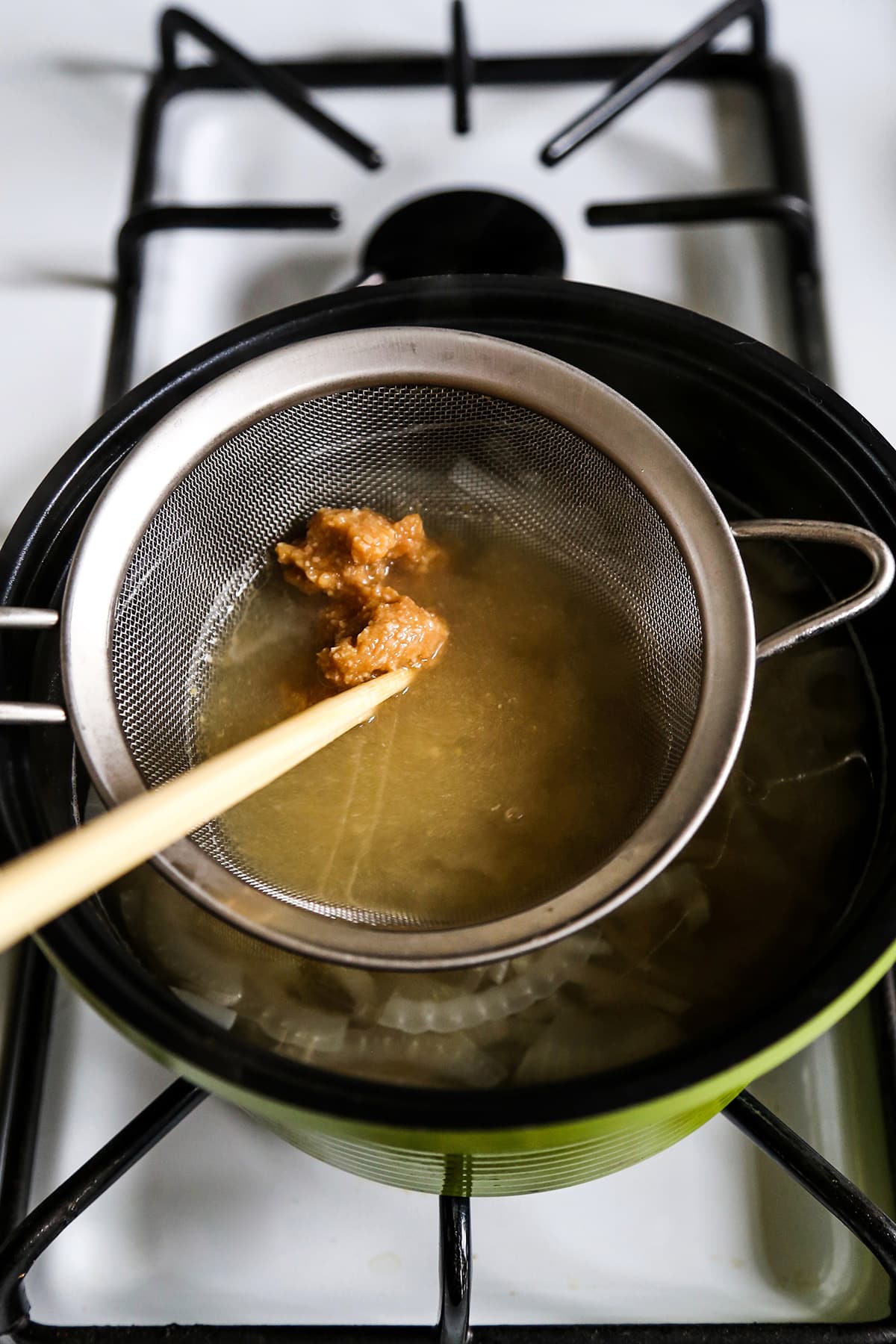
Expert Tips
- Drink it hot but not boiling. Miso soup is best enjoy when it’s eaten hot and not boiling. That’s because the flavors of the soup are delicate and more pronounced when the temperature isn’t too elevated.
- Use the sweetest onions to enhance amami. Amami means sweet taste in Japanese. My mother’s miso soup tastes best when it’s made with a sweeter type of onion so it infuses the broth with sweetness. Onions such as Vidalia or Walla Walla are good options, as well as yellow onions. Avoid using white onions as they have a strong astringent taste.
Storage
- Fridge: Let the miso soup cool to room temperature first. Transfer it to a storage container and refrigerate it for up to 3 days.
- Freezer: Let the miso soup cool to room temperature first. Next, I recommend dividing the soup into individual serving size so it’s easier to reheat the right amount. Use airtight storage containers or airtable sealable storage bags. Freeze for up to 3 months.
- Reheating: To reheat miso soup, put the miso soup in a pot and simmer on low heat. Do not boil miso soup as it’s bad for the miso paste and will affect its taste and delicate aroma.
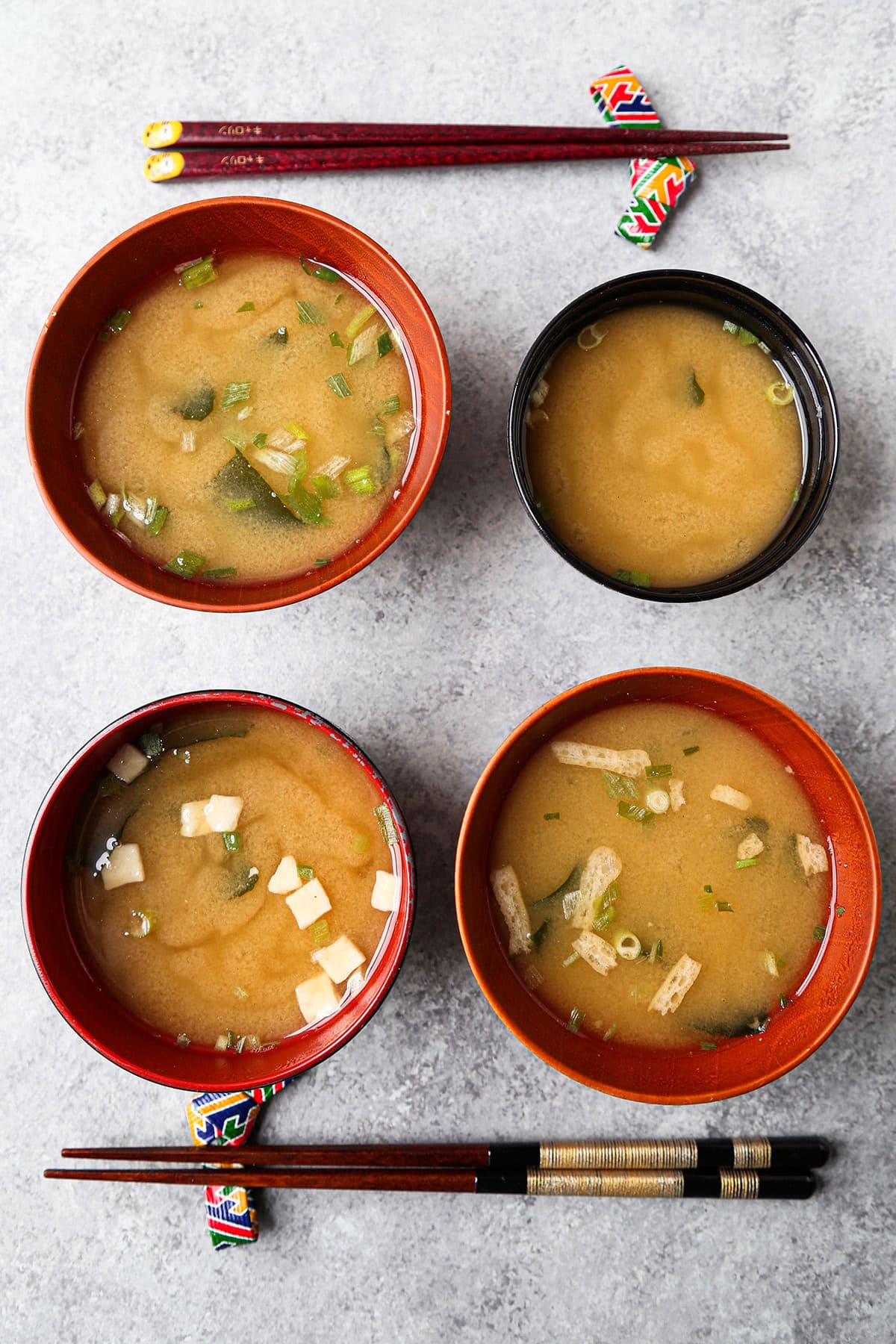
What To Serve With
To me, miso soup, or miso shiru, is what I like to serve in the morning as part of a Japanese breakfast with rice and a piece of salted salmon (shiozake), or as a side to noodles, stir fries, and rice bowls, for lunch or dinner.
Here are some of my favorite dishes to pair with miso soup:
- Japanese curry rice
- Omurice
- Spicy tuna roll
- Baked Chicken Katsu
- Rice and natto
- tamago kake gohan
- Yaki udon
Frequently Asked Question
Some instant miso soups are delicious! But there are so many brands to choose from that it can be very confusing to pick one. My favorites are Hikari Instant Awase Miso and Marukome Instant Ryotei no Aji.
Yes, miso soup is very rich in vitamins, minerals, and probiotics. Because of the fermentation process, miso soup is good for the digestive system and can help with acid reflux. It’s also good for the heart and may reduce the risk of certain types of cancers, such as stomach cancer. However, miso soup can be very high in sodium and may raise your blood pressure, which can lead to heart disease. Make sure to read the label to see how much sodium each serving of miso contains.
It depends of the miso paste used. It’s important to read the label if you suffer from gluten allergies since some miso pastes can contain fermented grains like wheat and barley. Look for one that is 100% gluten-free.
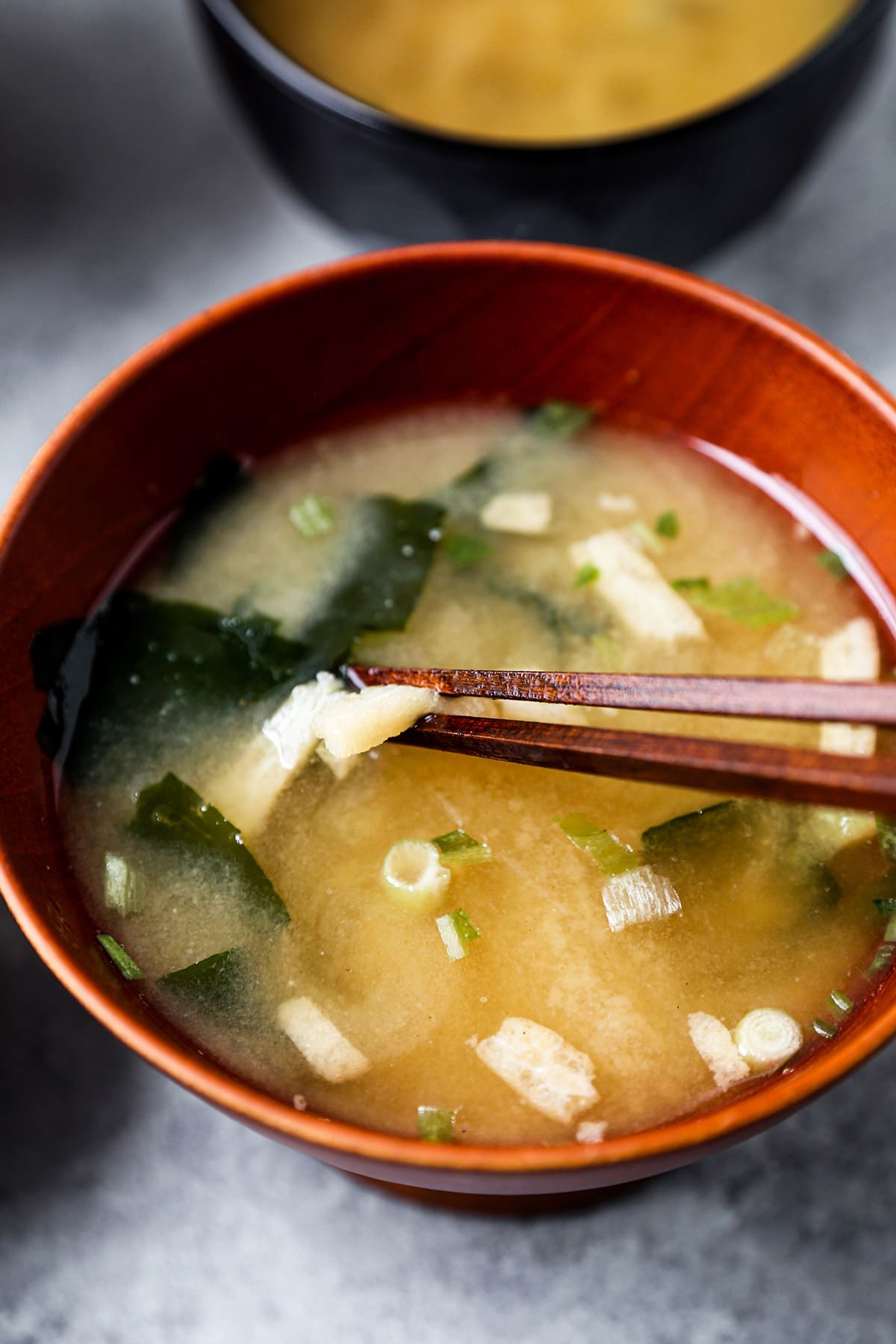
Did you like this miso soup recipe? Are there changes you made that you would like to share? Share your tips and recommendations in the comments section below!
Print
The Best Miso Soup
- Prep Time: 5 minutes
- Cook Time: 10 minutes
- Total Time: 15 minutes
- Yield: 4
- Category: Soup
- Method: Stove top
- Cuisine: Japanese
- Diet: Low Calorie
Description
This is a simple miso soup with sliced onions just like the way my Japanese mother makes it!
Ingredients
- 1 large onion, thinly sliced
- 4 cups water
- 1 tablespoon powdered dashi
- 3-4 tablespoons preferably white miso paste or awase miso paste
- Ichimi togarashi (optional)
Instructions
- Make the broth. Put the sliced onions, water and powdered dashi in a pot and bring to a boil. Lower the heat, cover and cook for 10-12 minutes, until the onions are tender.
- Add the miso paste. Place the miso paste in a small strainer and lower the strainer into the pot, until the liquid covers the miso paste. Stir the miso paste with chopsticks until it has fully dissolved.
- Serve. Turn the heat off and serve.
- Add a little heat (optional). Sprinkle a little ichimi togarashi for heat.
Notes
This miso soup will keep for 3 days, refrigerated in an airtight container.
Nutrition
- Serving Size: 4
- Calories: 42
- Sugar: 1.7g
- Sodium: 23.4mg
- Fat: 0.8g
- Saturated Fat: 0
- Unsaturated Fat: 0
- Trans Fat: 0
- Carbohydrates: 7.1g
- Fiber: 1.4g
- Protein: 2.1g
- Cholesterol: 0.3mg



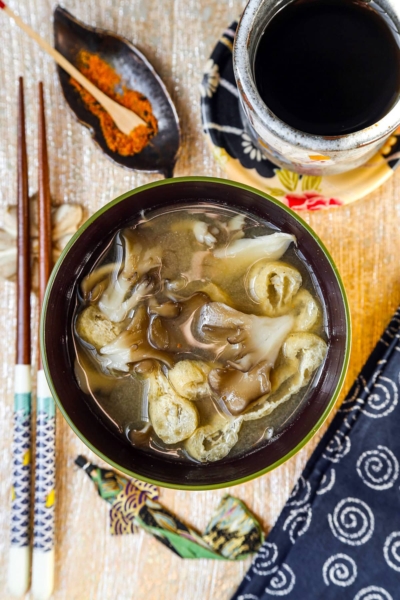


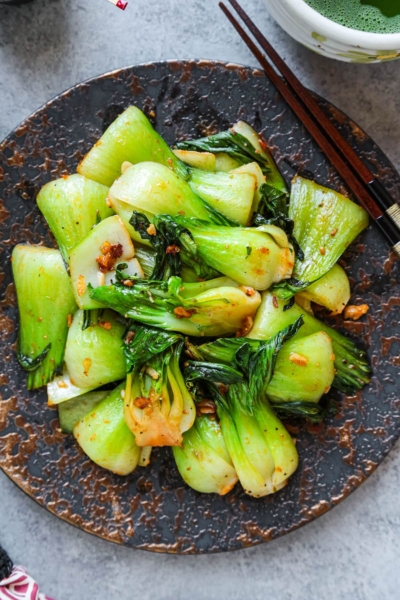

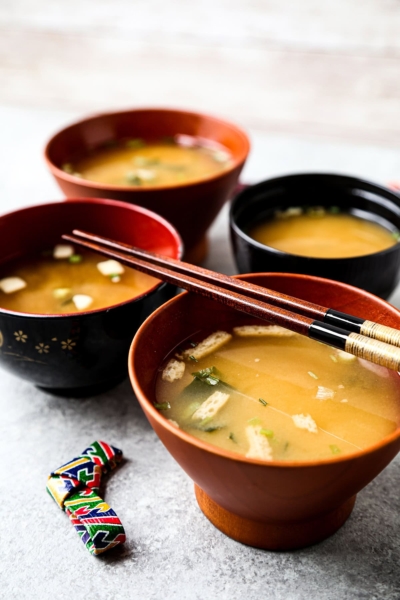

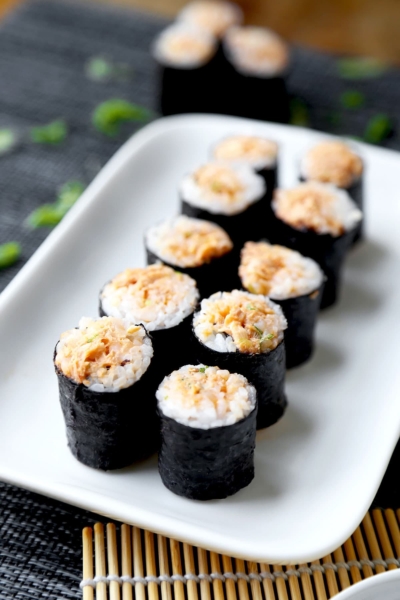








Questions and Reviews
The onions take this traditional recipe to the next level. I set my mandolin slicer on the thinnest setting and the onions practically melt into the soup, adding an awesome layer of flavor. I also add a bit of seaweed and some soft tofu. I love all of the textures. White miso is the best choice for a bit of sweetness.
I’ve made several Miso versions based on your Mom’s recipe all simply awesome! I ordered suggested items as I wanted authentic as I could living in Connecticut offered challenges. Looking forward to the next curry recipe. How fun this is!!!
Thank you so much Dennis! I will let my mom know how much you enjoy her recipe 🙂
The perfect thing to eat when you wake up with a hangover at 3 am.
Thanks again for this recipe. I used the miso to make yaki onigiri chazuke the other night. I still used the onions, but removed them once they’d steeped for a smooth soup. I’m addicted!
Made this this morning and it was delicious. As a side note, if you want to bump up the health benefits of any miso soup make sure to find unpasteurized miso. Most miso in the market and on Amazon is pasteurized which kills off all the wonderful probiotics from the fermentation process. My favorite is South River Miso. It is certified organic and unpasteurized. I only used 1 Tbsp rather than the 3-4 as this brand of miso can really bring the “funk” due to continuous fermentation. My favorite variety is the 3 year barley which is a dark miso. I also use Yamasan brand dashi.
I’ve made this delicious soup at least 7 times already. It’s super easy to make and it tastes great. Sometimes, I used red onions. Sometimes yellow, sweet onions. No matter which kind, the soup always comes out great. There’s an organic miso I find in the local stores which looks kind of dark so it’s probably red miso. The dashi is a package, different from what I see in the photos on this webpage but I find it quite easily in Japanese stores. I stick to the recipe because it’s simple and always tastes fantastic. It’s never in the refrigerator for more than 2 days because it simply disappears! I add green onions at the end sometimes and once even cracked an egg in. I always add the ichimi because I love it and it’s easy to find on Amazon. Everything seems to work as it’s a great recipe that I make over and over again.
Thank you so much, Bruce! 🙂
Absolutely the best miso soup that I have ever tasted and I am thrilled that I can make it whenever the urge strikes! Used 5 cups of water with no loss of taste and togarashi is a must. Thank you 🙂
Thank you so much Myrna! 🙂
This really is the best recipe, once you have the ingredients it’s pretty easy. The whole family thinks it tastes better than the miso soup from our favorite sushi resaurant 🙂
So easy to make, and so, so yummy! Thank you
An umami bomb and so simply delicious. I did add some sesame oil, togarashi, low sodium soy sauce. Wakami, bok choy greens,scallions ,shaved carrots and dashi